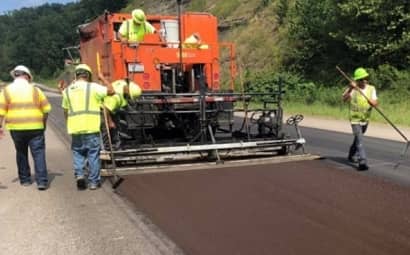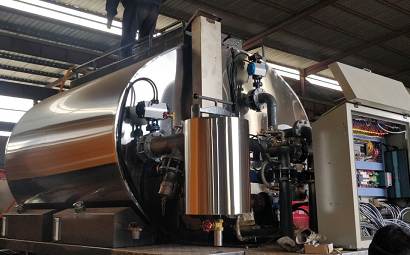Emulsified asphalt is an emulsion formed by asphalt dispersed in water. The water in it is only a temporary medium in the asphalt. After the emulsified asphalt is sprayed or mixed, it breaks the emulsion and the water in the emulsified asphalt evaporates. The ratio of water to asphalt in emulsified asphalt not only affects the production and transportation costs of emulsified asphalt, but also has a significant impact on the storage stability, viscosity and other indicators of emulsified asphalt. Therefore, it is necessary to test the asphalt content in emulsified asphalt.
In order to detect the asphalt content in emulsified asphalt, the emulsified asphalt needs to be dehydrated. However, different countries and organizations have different methods for dehydrating emulsified asphalt. In summary, there are four main methods: distillation, oven evaporation, direct heating evaporation and natural drying.

1. Distillation method
The more representative distillation methods are the distillation method of ASTM in the United States, the low-temperature vacuum distillation method of ASTM, and the distillation methods with different distillation temperatures and distillation times used in many states in the United States.
(1) ASTM distillation method. The United States ASTM D244-00 stipulates three methods for extracting emulsified asphalt residue: Residue and oil distillate by distillation, Residue by evaporation, and low-temperature (135°C) vacuum distillation. The ASTM distillation method is to pour 200g of modified emulsified asphalt into a special aluminum alloy container and distill it at 260°C for 15 minutes to separate the water and asphalt in the emulsified asphalt. The residue obtained by this method can also be used to test the properties of residual asphalt.
(2) ASTM low-temperature vacuum distillation method. Considering that some emulsified asphalts, especially modified emulsified asphalts, are distilled at high temperatures, the properties of the residual asphalt obtained will be greatly affected and cannot truly reflect the actual state of the emulsified asphalt during use. Therefore, the low-temperature pressure distillation method was added to the 2000 edition of ASTM D244. This method uses a distillation instrument and distills at 135°C for 60 minutes.
(3) Distillation methods with different distillation temperatures and distillation times used in many states in the United States. Many states in the United States use distillation to obtain emulsified asphalt residues, but the specific methods are not the same: Illinois and Pennsylvania use a method of distilling at 177°C for 15 minutes, Kansas uses a method of distilling at 177°C for 20 minutes, Oklahoma uses a method of distilling at 204°C for 15 minutes, and so on.
2. Oven evaporation method
The more representative ones are the ASTM evaporation method and the method of California, USA.
The ASTM evaporation method is to take four beakers with a capacity of 1000mL, pour 50g ± 0.1g of the stirred emulsion into each beaker, and then put them into an oven with a temperature of 163°C ± 2.8°C for heating for 2h, take them out and stir them thoroughly, then put them into the oven for heating for 1h and take them out to measure the index of the residue.
The method in California, USA is to take 40g ± 0.1g of emulsified asphalt, keep it at 118℃ for 30min, then heat it to 138℃, keep it at 138℃ for 1.5h, stir it, and keep it at 138℃ for 1h. The obtained residue is made into relevant test specimens to measure the index.
3. Direct heating evaporation method
Both Japan and my country use this method. The test for the evaporation residue of emulsified asphalt in my country is to heat and stir 300g of emulsion on an electric furnace for 20-30min, confirm that the water has completely evaporated, and then keep it at 163℃ ± 3℃ for 1min, and then measure the index of the residue after filling the mold. This test method is formulated with reference to Japanese standards.
In addition, in order to obtain the ratio of asphalt to water in emulsified asphalt, it can be obtained not only by detecting the asphalt content in the emulsified asphalt, but also by detecting the water content in the emulsified asphalt. ASTM D244-00 also has a test method for the water content in emulsified asphalt.
The residue content and properties obtained by different methods of obtaining residual asphalt are different.
Experimental research has found that the method of drying in an oven for a period of time often results in incomplete evaporation of water; the ASTM distillation test results are stable, but due to the relatively complex test equipment, it is currently difficult to promote in my country. Although my country's method of directly heating to 163°C to obtain residues will be affected by human factors, the method is simple, the test results are credible, and it is basically feasible.
 Albanian
Albanian  Russian
Russian  Arabic
Arabic  Amharic
Amharic  Azerbaijani
Azerbaijani  Irish
Irish  Estonian
Estonian  Odia (Oriya)
Odia (Oriya)  Basque
Basque  Belarusian
Belarusian  Bulgarian
Bulgarian  Icelandic
Icelandic  Polish
Polish  Bosnian
Bosnian  Persian
Persian  Afrikaans
Afrikaans  Tatar
Tatar  Danish
Danish  German
German  French
French  Filipino
Filipino  Finnish
Finnish  Frisian
Frisian  Khmer
Khmer  Georgian
Georgian  Gujarati
Gujarati  Kazakh
Kazakh  Haitian Creole
Haitian Creole  Korean
Korean  Hausa
Hausa  Dutch
Dutch  Kyrgyz
Kyrgyz  Galician
Galician  Catalan
Catalan  Czech
Czech  Kannada
Kannada  Corsican
Corsican  Croatian
Croatian  Kurdish (Kurmanji)
Kurdish (Kurmanji)  Latin
Latin  Latvian
Latvian  Lao
Lao  Lithuanian
Lithuanian  Luxembourgish
Luxembourgish  Kinyarwanda
Kinyarwanda  Romanian
Romanian  Malagasy
Malagasy  Maltese
Maltese  Marathi
Marathi  Malayalam
Malayalam  Malay
Malay  Macedonian
Macedonian  Maori
Maori  Mongolian
Mongolian  Bengali
Bengali  Myanmar (Burmese)
Myanmar (Burmese)  Hmong
Hmong  Xhosa
Xhosa  Zulu
Zulu  Nepali
Nepali  Norwegian
Norwegian  Punjabi
Punjabi  Portuguese
Portuguese  Pashto
Pashto  Chichewa
Chichewa  Japanese
Japanese  Swedish
Swedish  Samoan
Samoan  Serbian
Serbian  Sesotho
Sesotho  Sinhala
Sinhala  Esperanto
Esperanto  Slovak
Slovak  Slovenian
Slovenian  Swahili
Swahili  Scots Gaelic
Scots Gaelic  Cebuano
Cebuano  Somali
Somali  Tajik
Tajik  Telugu
Telugu  Tamil
Tamil  Thai
Thai  Turkish
Turkish  Turkmen
Turkmen  Welsh
Welsh  Uyghur
Uyghur  Urdu
Urdu  Ukrainian
Ukrainian  Uzbek
Uzbek  Spanish
Spanish  Hebrew
Hebrew  Greek
Greek  Hawaiian
Hawaiian  Sindhi
Sindhi  Hungarian
Hungarian  Shona
Shona  Armenian
Armenian  Igbo
Igbo  Italian
Italian  Yiddish
Yiddish  Hindi
Hindi  Sundanese
Sundanese  Indonesian
Indonesian  Javanese
Javanese  Yoruba
Yoruba  Vietnamese
Vietnamese  Hebrew
Hebrew  Chinese (Simplified)
Chinese (Simplified)






